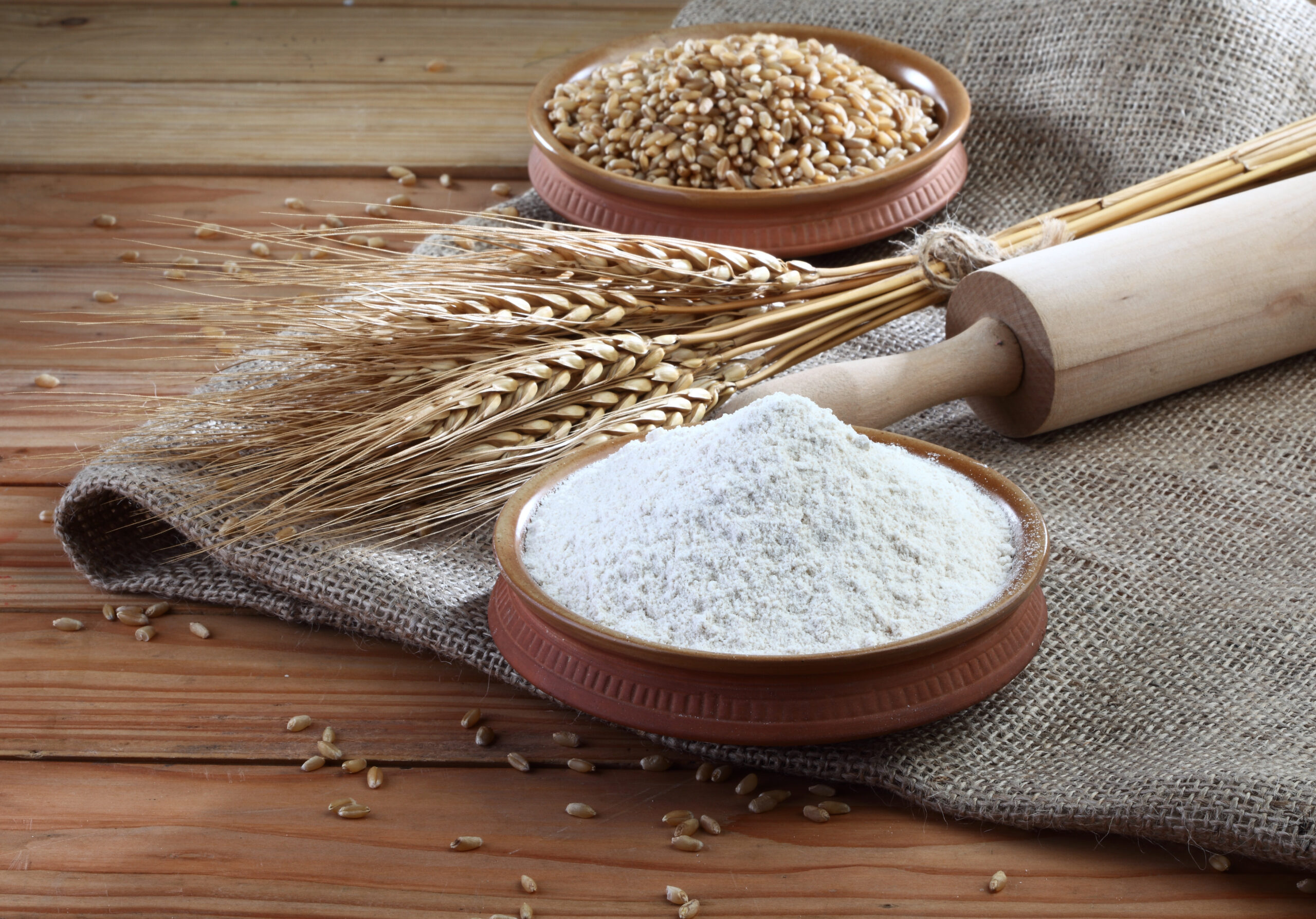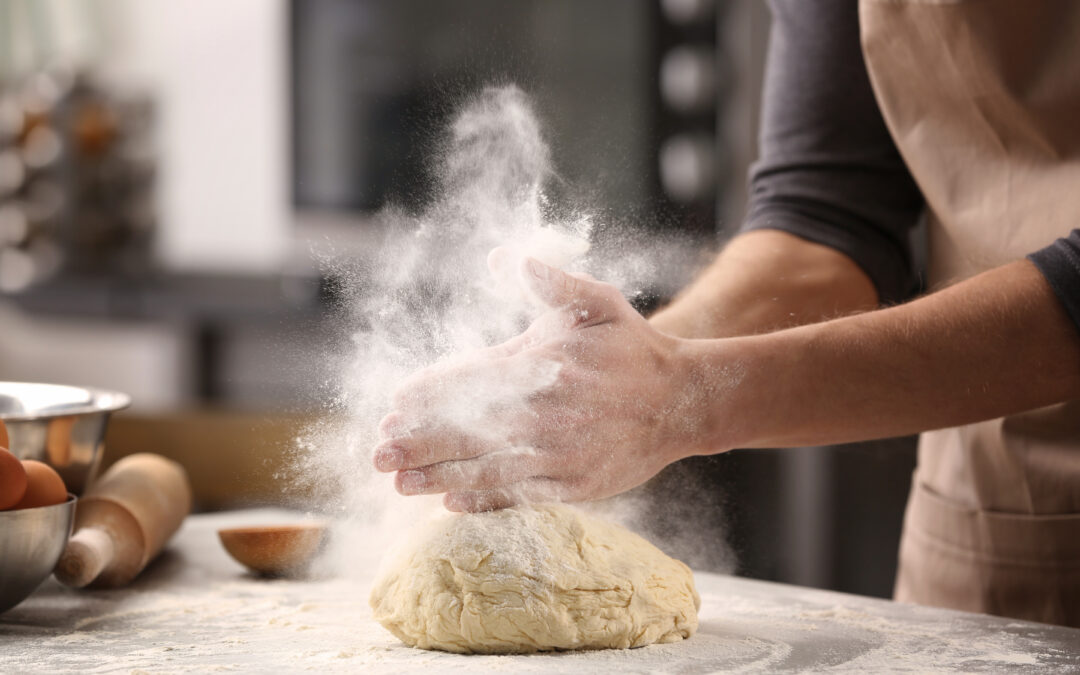In the baking process, wheat flour provides the structure for yeast raised and chemically leavened products. Breads, pastas, pastries, and other baked goods require specific performance attributes of flour to achieve the desired outcome. For tortillas and pizza dough, extensibility is key, where the characteristics of pastry flour affect the viscosity of the batter and volume, crumb texture and softness of the cake.
In some cases, bakers will use chemicals to correct flour. Common examples include:
● Bromate. While use is prohibited by law in most all countries, potassium bromate has been well-known for its ability to strengthen dough and lead to greater oven spring.
● ADA (azodicarbonamide). With its use also diminishing due to consumer and governmental health concerns,, this chemical acts as a oxidizing agent to promote the formation of disulfate bonds to strengthen doughs.
● DATEM (diacetyl tartaric acid ester of mono- and diglycerides). DATEM strengthens dough for better expansion during proofing and baking.
● Sodium stearoyl lactylate (SSL). Often used in commercial food production, SSL increases the shelf-life of baked goods.
● Guar gum. Using guar gum in baked goods can enhance their consistency and prolong their shelf life.
● Xanthan gum. Xanthan gum improves dough binding, especially in gluten-free baked goods.
Using chemicals like the ones described above can result in issues such as consumer perception, difficulty sourcing, and increased regulatory restrictions. It’s ideal if you can avoid the long-term use of chemicals when attempting to correct flour.
In 2022, flour production broke records in the U.S., amounting to the biggest increase since 2007. Even more growth is anticipated, with the U.S. Department of Agriculture (USDA) predicting an expansion of nearly 22.5 million tons — for a total of 230.4 million tons — by as early as 2032.
To the average consumer, flour seems like a fairly straightforward ingredient. It’s just the ground form of raw wheat, right? But to those in the food industry, it is understood that flour is more than just a basic food ingredient. It’s a remarkably complex ingredient with three main components: bran, germ, and endosperm.
The transitional layer between the endosperm and the bran (often ending up in flour) is the aleurone layer.
The separation and combination of those three parts during the milling process can create various flours, that are unique in their function and use. Flour characteristics include protein, ash content, starch content, particle size, hydration properties, and oil absorption. Additive choices impact these characteristics to aid in the production of quality products.
Given the complexity of what may appear to be a simple cooking ingredient, let’s take a closer look at flour, from its challenges and advantages to the substance’s scientific properties.
Common flour problems
Common flour problems that commercial bakers often face can include:
● Consistency. Ingredient variability, nuances in equipment, and different storage methods can cause baked goods to vary in taste and quality.
● Development. Under mixing will keep gluten from being developed to its optimum, while over mixing can destroy protein structure to weaken the dough.
● Water absorption. Over or under hydration of dough will affect both dough handing and gluten development.
● Fermentation tolerance. Inadequate gluten content and development can lead to problems in the fermentation/proof to hold dough structure.

Understanding enzymes
Flour naturally contains enzymes, which are created by all types of living organisms and cause specific biochemical reactions or chemical conversions. In the case of flour, enzymes are often further added that can accelerate chemical changes, such as breaking down fiber and forming gluten structure in doughs and batters.
In more concrete terms, enzyme activity can boost the quality and strength of bread dough. Enzymes can also mitigate bakery production issues like dough and bread quality inconsistencies. When those involved with bread baking make slight adjustments using enzymes it is called “flour correction.”
Enzymes used in flour correction include alpha-amylase (α-amylase), protease, lipase, xylanase, and amyloglucosidase. Those enzymes cause different activities to occur in flour after the wheat is milled.
Enzymes for flour correction
The flour correction enzymes differ in function.
● Alpha-amylase enzymes improve bread volume and breadcrumb structure by breaking starch chains into smaller pieces.
● Protease cleves protein structure into smaller amino acid peptides that make the dough easier to maneuver.
● Lipase and phospholipase create internal emulsions in bonding fats and water to strengthen the gluten in the dough, improving its stability and crumb structure.
● Xylanase and Pentosanase breaks down the hemicellulose compounds typically found inside wheat flour. If these components remain intact, flour hydration and dough extensibility can be limited.
● Glucose oxidase enzymes improve the oxidation of the protein matrix by promotion of disulfate bonds which strengthen wheat flour dough, improving bread volume, crumb structure, and whiteness.
● Amyloglucosidase enzymes enhance the fermentation process in bread production by producing individual reducing sugars which feed yeast.
● Maltogenic amylase enzymes increase moistness, softness, and texture in baked goods.
● Cellulase enzymes improve the handling and conditioning of doughs and can be especially helpful in producing quality whole wheat products.
Applications for enzymes used in flour correction
Enzymes are also used in flour correction, including:
● Bread making. In making bread, enzymes cause biochemical reactions that improve the physical structure of the dough and improve yeast performance.
● Cake making. Enzymes affect the degree of softness and moisture retention in cakes.
● Pastry making. Enzymes improve the shelf-life of pastries and ensure they remain fresh for longer periods.
● Noodle making. By enhancing the gluten performance of lesser-quality flour, enzymes increase the quality of dry noodles.
Advantages of using enzymes in flour correction
The benefits of using enzymes in flour correction are numerous. Chief among them is improved flour quality, reduced cost of production to utilize lower grade wheats, and improved dough handling properties.Bakeries benefit from using enzymes in flour correction because the manufactured bread, cake, pastry, and noodle products they produce have a longer shelf-life. Products having a longer shelf-life alleviates manufacturing and production costs.
Consumers also benefit from the use of enzymes in flour correction. Because the process results in products lasting longer, customers who purchase them can expect items not to stale as quickly as they otherwise would. When consumers can keep products longer, the result can be a decrease in food waste.
From an aesthetic perspective, using enzymes in flour correction improves volume, crust color, and crumb structure in bread, cake, pastry, and noodle products.
Challenges of using enzymes in flour correction
Despite all the benefits of using enzymes in flour correction, there are some important considerations, including enzyme application, stability in storage and the correct concert with enzyme types and other additives.
In terms of performance, the amount of enzymes used in flour correction is critical. A slight deviation from the proper amount can adversely affect the product, negatively impacting its appearance and sensory attributes. In other words, improper use of enzymes can have the opposite effect as intended.
Additionally, using enzymes in flour correction incorrectly can lead to poor crumb structure, undesirable textures, and unattractive crust coloring. In most cases, overdosing of enzymes produces greater negative effects than using too little.
Produce high-quality flour with help from Engrain
The importance of flour correction, and the use of enzymes in the process, can’t be overstated. Thanks to the introduction and increased use of enzymatic supplements, the quality of bakery products is higher than ever.
Engrain is devoted to improving dough handling, crumb texture, crumb color, and volume bakery products through proper understanding and use of ingredient tools.
According to Engrain, “Flour millers now have the opportunity to optimize their principal raw material cost by sourcing lower protein wheat while meeting or exceeding customer performance expectations.”
Our volMAX Flour Technologies improve loaf volume, water absorption (through hydrolysis), and crumb texture. Dough extensibility and handling are enhanced with high P/L characteristic flours. Higher ash flours, even beyond 10% bran inclusion, can produce bread with volume and texture characteristics similar to premium white bread.
Get started with Engrain today.
